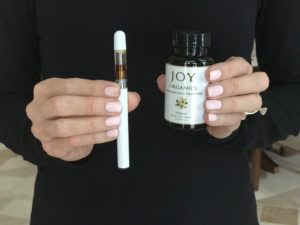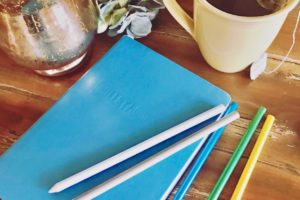Not too long ago, my husband sent me an article in which the author described her anxiety attacks. He said, “This sounds like you.”
When I finished reading, I immediately did a Google search on anxiety, and I couldn’t believe what I saw. I scrolled through article after article about Generalized Anxiety Disorder (GAD), and it was as if the writers were talking about me.
For as long as I can remember, I’ve dealt with irrational fears, panicky feelings, shortness of breath, obsessive, continual thoughts swirling around in my head, jumpiness, racing heart, the inability to turn off my thoughts, restlessness, extreme worry, overthinking, and a number of other physical and mental symptoms. I always thought these things were just part of my personality.
The more I read, I knew without a doubt that I had been dealing with GAD for decades. My husband and I started to connect the dots between past situations and my behaviors and reactions over the years. Now, in my 50s, it all started to make sense.
With help, I began to identify things that trigger my anxiety, and I started learning coping skills and strategies to manage my anxiety naturally without resorting to prescription drugs.
These strategies have empowered me to grab the reins of my mind and have given me more control over situations, rather than allowing them to control me. When I feel anxiety approaching, I have a plan now.
This is how I’ve learned to cope. Maybe these can help you, too, if you struggle with anxiety.
1. Identify triggers
Triggers are very personal and can be physical or emotional, and they can be different for everyone. Things to consider include diet and caffeine intake, past negative or traumatic experiences, major life changes or stressors, health or family issues, finances, social situations, or others.
Think through what triggers your anxiety and how you react emotionally and physically. Awareness, understanding, and preparation can help lessen the trigger’s effect and can help us implement systems to better cope. When we know what sets off our anxiety, we can be more prepared and empowered.
2. Set boundaries and eliminate stressors when possible
Once you know your triggers, eliminate the ones you can. For example, small spaces or feeling trapped are triggers for me. I have to be near an exit. When traveling, I always get an aisle seat, I sit near doors in meeting rooms, and I rarely drive in the middle lane. This gives me more control over my feelings of claustrophobia, and I’m able to be more relaxed.
Another of my triggers is conflict, and although it’s not always avoidable, I’ve chosen to set boundaries in certain areas. For example, I will not get into political discussions or watch opinion news programs anymore; they’re too toxic. This doesn’t mean I’m uninformed, I just have more control over what I allow in my head by setting these and other boundaries.
3. Consider using Cannabinoid (CBD) 
I started using CBD last year as a natural way to deal with my anxiety, and I’ve seen excellent results. I use high-quality, organic CBD, which is legal in all 50 states. The products I use do not contain even a trace of THC (the element that gets you high) so there is no “high” feeling whatsoever.
With CBD, it’s more about what I don’t feel rather than what I do feel. Learn more about CBD and the products I use here.
4. Declutter Your Mind
Clutter is another trigger for me. I don’t function well in a cluttered, messy environment. Anxious, swirling thoughts and worries are mind clutter. I use this visualization exercise to eliminate unwelcome thoughts.
I picture my mind as a room and see my worries as piles of messes all around. I identify each worry and then start to clean up the messes one by one.
With repetition, this mental exercise of tidying up my thoughts helps me get back to living in the present moment instead of reliving past stuff or worrying about the future.
5. Smell Flowers and Blow out Candles
 You probably know the benefits of timed breathing exercises—when you inhale deeply for several seconds, hold, and then exhale slowly. You’re encouraged to close your eyes, sit still or even lie down, and visualize something positive, but sometimes the situation doesn’t allow for these luxuries. Your heart rate is starting to race, and anxiety is coming on you fast.
You probably know the benefits of timed breathing exercises—when you inhale deeply for several seconds, hold, and then exhale slowly. You’re encouraged to close your eyes, sit still or even lie down, and visualize something positive, but sometimes the situation doesn’t allow for these luxuries. Your heart rate is starting to race, and anxiety is coming on you fast.
Picture your favorite fragrant flower. Now take a deep breath and inhale its aroma. Hold. Then imagine a gently flickering candle, and blow it out. Exhale slowly. Repeat as many times as needed.
Flowers and candles. You can use this breathing technique anywhere to put the brakes on anxiety’s grip.
6. Be your own coach
Self talk is a powerful tool. You’re in charge of the narrative in your head, so be your own coach and give yourself frequent pep talks.
Research shows that positive self talk leads to all kinds of benefits such as increased life span, lower rates of depression, lower stress, better resistance to disease, better overall well-being, better coping skills, and on and on.
Take control of swirling anxious thoughts. Don’t let them control you. Try these re-grounding or re-centering questions:
- Who do I want to be?
- Am I being that person? Why or why not?
- How much control do I have over this situation?
- What can I let go of?
7. Use truths to reassure yourself
Start a list of positive things that are true for you, and keep the list in a prominent place you can see throughout the day for reassurance. Think through these questions:
- What are your values?
- What are you grateful for?
- What is good in your life right now?
- What benefit does worry bring?
- What do you have control over?
8. Release by journaling 
Through journaling, you can log ideas, write down goals, relax, keep organized, and release toxic or stressful thoughts that keep you in a mental prison.
I use a bullet journal to keep track of my schedule, to-do list, goals, important reminders, and inspiring quotes. For me, this is a relaxing and meditative practice because I also add artistic elements to my journal.
9. Do something physical.
Exercise. Cook. Laugh. Take a walk. Change what you’re doing. Change your environment.
Exercise, whatever kind, is beneficial when feeling anxious. It releases feel-good endorphins, takes your mind off of worries, and it gives you a mental boost.
I belong to an exercise studio and take 4-6 classes a week. When I’m in a class with the music pumping and my muscles shaking, I can’t think of anything else. It’s an hour a day where my mind is totally in the moment. Plus, the benefits are lasting.
10. Let go of uncontrollables
“Grant me the serenity to accept the things I cannot change,
the power to change the things I can,
and the wisdom to know the difference.”
~Serenity Prayer~
What is in your power to change? How can you change it? What can’t you change?
If you can’t change your situation, change your attitude, your actions, your behavior, your surroundings. Change what you can, and let go of what you can’t, and remember that uncontrollables are a time and energy suck, so let them go.
Whether you deal with Generalized Anxiety Disorder or the occasional bout, try these strategies to lighten anxiety’s grip.
If you have other strategies or techniques for coping with anxiety, please comment, and if you’d like your comment to remain private, please note that.
I’d appreciate you sharing this with someone who may find it useful.
xo, Lisa


You just helped me. It’s my belief that my own anxiety is rooted in existential circumstances. (Taking care of two dying parents who were diagnosed as dying and also my husband who had a stroke has not been relaxing). At the end of the day, my best coping skill is connecting with angels like you. Even though you’re not local, YOUR LIGHT SHINES BRIGHTLY, AND I APPRECIATE YOU BEYOND WORDS. ✨✨✨
I’m sure your situation is both stressful and emotionally/physically draining! I, too, enjoy the mini escape through Instagram by looking at the fashion, photography, travel, and other content I follow, and especially connecting with friends like you! Thank you for reading and for your encouragement!
xoxo, Lisa
Fantastic post, thank you so much! These are fantastic suggestions, and information like this is empowering. Really well done!
Amy,
Thank you so much for reading and joining the conversation.
xo, Lisa
These are wonderful thought out strategies. I have been self coaching myself as well. It is so important to to redirect negative thoughts and keep only the ones that make you stronger.
Lisa,
I couldn’t agree more about the benefits self coaching and keeping a positive mindset. Thank you for reading 🙂
xo, Lisa
Loved this post Lisa. I have quite a few similarities to you. I get shortness of breath. I’ve identified, this is when I’m in a certain situation and not comfortable. I also have mild claustrophobia and always have an aisle seat – strange isn’t it?
many thanks
Alison
xx
Hi Alison,
I, too, deal with shallow, hyperventilated breathing when in anxiety mode. A nurse friend of mine suggested to focus on breathing out…like blowing out candles…because in an anxious state, I sometimes just breathe in and can’t breathe out! I have to make that a focus.
Thanks for reading and commenting.
xo, Lisa
Excellent post Lisa.
It is so much easier to identify the symptoms and roots of anxiety when outlined as you have done here.
I believe that most of us suffer bouts of anxiety at different points in our lives. And most times it’s goes unrecognized.
Hormonal changes during menopause, along with life changes ( deaths, health issues, college, job changes etc.) can be huge triggers for panic attacks.
Thanks for sharing your experiences.
xoxrd
Rosemary
So true, Rosemary. I read that over 40 million adults suffer from anxiety, and nearly 7 million from GAD, like me. Thanks for reading and commenting.
xo, Lisa
Great post! Thanks so much for sharing! I also use CBD and it helps tremendously!!
Christine,
Good to hear about your CBD…I’m so glad I found it, too. I use it every day and really does help. Thanks for reading and commenting…appreciate you!
xo, Lisa
I almost think this could be my husband…you make such good points here.
Needless to say he’s not a CbD fan. Is there anything else that could help?
XOXO
Jodie
http://www.jtouchofstyle.com
Ps. I don’t see your replies to my comments so you could email me at jodie@jtouchofstyle.com if you have ideas.
JOY ORGANICS CBC has truly changed my life! I have been taking these products for 2 months now and my anxiety has been kicked to the curb! Thank you for your recommendation…..I can pass along to your readers that, for me, Joy Organics has been money well spent.
Leigh Ann,
Thanks so much for reading and for sharing your experience. It’s truly been a game-changer for my anxiety, too. I am a firm believer in these products and will continue to use and recommend them.
xo, Lisa
Lisa, I get Pharma GABA at the health food store to help me sleep but it is also used for those who experience anxiety. Here’s an article about GABA. Maybe this can help some people.
https://blog.bulletproof.com/gaba-neurotransmitter-supplement-anxiety-sleep/
Thank you for sharing that, Karin. I know that works for a lot of people, too. I’ve used it before, but personally, I get better results from the CBD, which contains ZERO THC. Thanks for reading and commenting.
xo, Lisa
Hi Lisa – I’m so glad I stumbled onto your IG page today which led me to this post. Thanks for sharing a little about your experience and thoughts on managing anxiety. I’ve been interested – but scared – about trying CBD but with your encouragement I think i’ll Move past the fear.
Hi Juliet,
I’m so glad you found me, too! 😊 Because CBD is relatively new on the scene, so many people have confusion or misconceptions about it. Personally, I’m more afraid of prescription drugs than CBD. I’ve found it very helpful for managing my anxiety naturally.
Best of luck with your journey 🙂
xo, Lisa